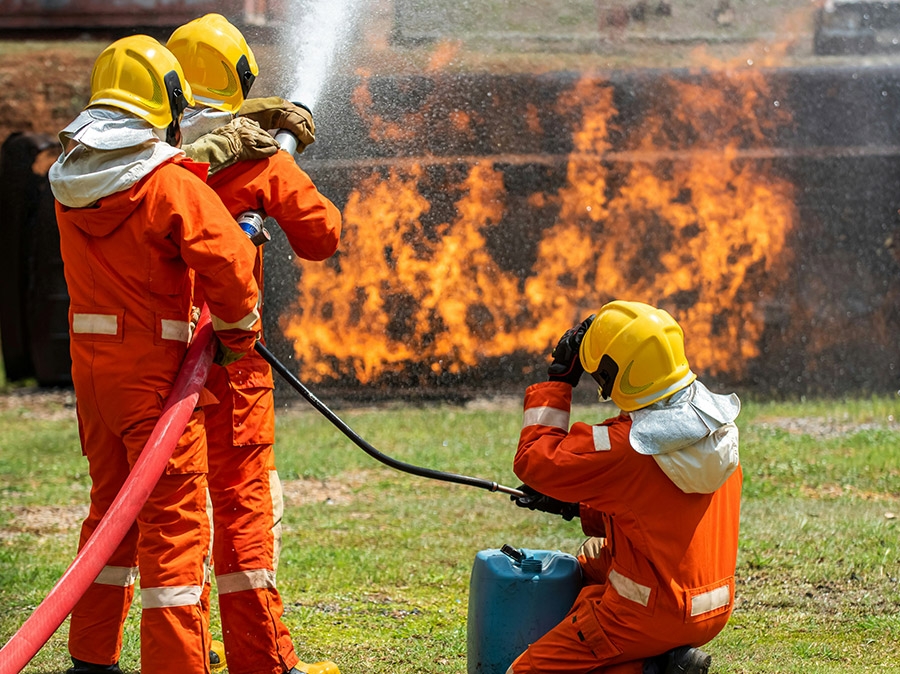Tags
Site Owner
SUPERYACHT TRAINING - MOVING UP THE RANKS
SUPERYACHT TRAINING - MOVING UP THE RANKS
Another Mediterranean summer is drawing to a close, the Monaco Yacht Show is about to light up, and exhausted crews are powering through the final leg of the season. That’s a wrap on Med 2025, you’ve counted your tips, counted your days, so… what’s next?
Maybe you’re thinking, “I’m ready to step up.” With crew reshuffling just around the corner, how can you, as a Head of Department, support your team? And as a junior crew member, how can you get the vital superyacht training and knowledge you need to move forward in your career?
Here’s a little from my own journey, after 15 years as a Hospitality Manager and Chief Stewardess.
Why Knowledge Sharing in Yachting Matters
The years go by quickly. It feels like yesterday I was in my 20s, starting out in the yachting industry. Looking back now, I’m grateful for the career I had, the doors it opened, the experiences it gave me, and the knowledge I gained.
But here’s the truth: knowledge means nothing unless it’s shared. Too often, when senior interior crew leave yachting at the end of their 30s, years of valuable yacht interior training and experience simply disappear.
That’s why I always made teaching a priority on board. My mantra was: train your team so they can do your job better than you – then you can take a longer break. Work smarter, not harder.
If you’re confident in your own skills, you should never fear someone stepping up to take your job. In fact, nothing made me prouder than seeing junior crew spread their wings and move up to Second Stews, Chief Stews, or even Pursers.
But here’s the reality: training and knowledge aren’t free. You have to earn them. I’ve worked with crew that expected to be handed opportunities without putting in the effort. That doesn’t work. You need to show your manager that you want it, that you’re willing to put in the extra time and energy. Only then will they invest in you.
As a HOD, I always asked my team about their goals. Was yachting a career path, or just a gap year? Were they interested in moving from laundry to service? There’s no point spending hours training someone who has no intention of progressing.
Because for most good managers, teaching is just as rewarding as learning is for you. A great manager is also a great teacher.
Practical Tips for Superyacht Crew Training (Interior Version)
Whether you’re a Head of Department or a junior just starting, here are some practical ways to keep crew training and career progression moving forward on board.
For Heads of Department (HODs)
Micro-train daily – You won’t find hours to dedicate to training mid-season, so grab little moments. Use service, turnarounds, or guest trips as live teaching opportunities.
Bring them in – Example: If guests are ashore before dinner and laundry is under control, get a junior stew to set the table with you. Talk them through the process.
Explain the “why” – Why the glass is placed here, why the label faces forward, why you use finger bowls, how the menu ties into the table setting.
Enforce time management – Don’t just say “set the table.” Say “set it by half past.” Deadlines matter.
Teach mise en place – Before setting up, have a plan. Example: Tomorrow is Japanese night. What do you need? Chopsticks, rests, sauce bowls, mixing bowls, deco fans, napkins, etc. Use a checklist until it becomes second nature.
Pass on short-cuts – Show practical tricks: using the right tray to save trips, loading the dumbwaiter efficiently. Every yacht is different, so don’t assume crew just “know.”
Delegate with purpose – Give responsibility in small steps. Let your team help with accounts, input receipts, or shadow provisioning. Small ownership builds big confidence.
Give feedback fast – Correct mistakes in the moment, kindly, and always explain the why. Feedback sticks best in the moment.
Lead by example – Be the standard before you expect the standard. Keep checking yourself, keep learning. If you don’t know something, look it up; the internet is in your hands.
For Junior Crew
Be proactive – Ask to shadow, take notes, and repeat tasks until you’ve mastered them. My first boat? I learnt how to iron a shirt from YouTube. If I could back then, well no excuses today!
Show commitment – Arrive early, stay focused, volunteer for the less glamorous jobs, they teach the most. HOD is working extra, offer to help.
Ask smart questions – Don’t just ask “how?” Ask “why?” You’ll remember the reasoning far better than a quick instruction.
Practice off-shift – Fold napkins, check over manuals, or study wine lists in your own time. It won’t go unnoticed.
Track your progress - Keep a record of what you’ve learned. At season’s end, you’ll have proof of growth – and leverage to ask for a training allowance, pay rise, or permanent role.
As this season wraps up, ask yourself: Are you sharing what you know? Are you showing that you want to learn?
The future of yachting careers depends on both. Whether you’re aiming for Chief Stewardess, Purser, or beyond, remember skills and knowledge aren’t just personal achievements. They’re the foundation of a stronger, more professional superyacht industry.
If you’re reading this, there’s a good chance you’ve already heard the term “dockwalking.” It’s a rite of passage for any green crew member hoping to land a job (we dockwalked at the start of our yachting careers too). But let’s be honest—it’s not the most glamorous part of the job hunt. However, if you’re willing to put in the time and effort, dockwalking can get your foot in the door—provided you do it right. Here’s your guide to navigating the docks like a pro.
Timing Is Everything
Approaching boats at the wrong time can be a surefire way to get shut out. It’s all about respecting the crew’s schedule while seizing those crucial windows of opportunity. So, when’s the best time to strike?
Mornings are golden. Most crews start with meetings, often around 7:50 a.m. The sweet spot for dockwalking is between 8:15 a.m. and 9:00 a.m.—after the morning briefing has wrapped up and the crew is transitioning into their day’s tasks. Arrive a little earlier, and you might catch some crew members hanging about before the meeting starts, but don’t interrupt the meeting.
Leaving your CV? Some boats put out a box with a note asking you to place your CV inside and not disturb the crew. Follow these instructions—after all, why would they want to employ you if you can’t follow simple tasks?
Under no circumstances should you stick your CV under the deck protection on the gangway, stuff it in the fire plan holder, put it under the welcome mat, or leave it in any other creative place you find. The deck crew won’t appreciate fishing your soggy CV out of the water or trying to spear it with a boat hook.
Afternoon dockwalking can also be worthwhile—it may help you secure day work for the following day, so it’s worth considering.
Avoid break times. The last thing you want is to interrupt someone during their downtime. Common break times to avoid include:
- 10:00 a.m. – Morning tea break
- 12:00 p.m. – 1:00 p.m. – Lunch hour
- 3:00 p.m. – Afternoon tea break
If you approach the docks during these periods, don’t be surprised if the crew is nowhere to be seen. Even if they are around, chances are they’ll be too preoccupied to chat.
Plan Your Approach
Dockwalking is no sprint—it’s a marathon. Instead of bouncing aimlessly from one marina to another, create a clear plan. Map out the areas you want to cover, and take note of boats you’ve already approached so you don’t waste time retracing your steps.
Be strategic with your route. It’s tempting to rush from marina to marina, but this can quickly drain your energy and enthusiasm. Plan your dockwalking over a few days or even weeks to ensure you cover all the bases. If you're based in a popular yachting hub like the French Riviera, why not venture as far as Italy? The train network makes it relatively easy to cover a lot of ground—even if you have to dodge the occasional strike.
Use apps to your advantage. Tools like MarineTraffic can help you check if a marina is busy before you leave your crew house.
Be Prepared
Dockwalking is all about making the right impression, and that starts with looking the part. It’s a cliché, but it’s true—first impressions count. You don’t need a suit and tie, but you should aim to look clean, smart, and ready for action. A decent polo shirt, shorts, and comfortable deck shoes should do the trick. And don’t forget a spare change of clothes, preferably something you don’t mind getting dirty.
Watch Out for Guests, Be Polite, Empathetic, and Brief
Nobody wants to be interrupted by a shout from the dock or an unexpected ring at the doorbell when there are guests on board. So, be respectful. If the crew is wearing polos or there are flowers and dock chairs out, it’s a clear sign that the yacht has guests onboard. Skip these vessels when dockwalking.
Here’s a golden rule: always approach crew members politely. A quick “Sorry to bother you, I know I’m probably the 20th person today, but I’m looking for work…” goes a long way in showing that you understand you’re interrupting them. Empathy can soften the encounter and make the crew more likely to engage.
Your pitch should be brief—15 to 20 seconds max. Think of it as an elevator pitch. You don’t need to go on about your entire work history. Focus on what makes you a good fit for a yacht, such as hands-on skills like carpentry or painting, or any previous day work experience.
The Unwritten Rule: Don’t Be a Pack of Seagulls
One of the biggest mistakes green crew make when dockwalking is showing up in groups. When approaching yachts, keep the numbers small—ideally, no more than two people. A group of five or more crew members loitering on the dock can be off-putting. The last thing a yacht needs is a pack of people trying to sell themselves all at once. And if the boat needs just one day worker—who gets it?
Also, do not shout “Hey, bro!” from the end of the gangway. Not only does this make you look unprofessional, but it’s also incredibly unlikely to get you a positive response. Approach the crew calmly, respectfully, and with a friendly tone.
Don’t Just Stand There—Take Notes!
When you're dockwalking, organisation is key. After speaking to a crew member, jot down the name of the boat, the person you spoke with, and any useful details, like when they might need day workers next. This helps you track your progress and prevents awkward situations where you approach the same yacht twice without remembering what was said.
Patience and Persistence Are Key
It’s easy to get discouraged if you don’t land a job straight away. Dockwalking is all about building relationships, so don’t expect instant results. Just because you don’t get a job on your first (or tenth) attempt doesn’t mean you won’t get one in the future. Every “no” is just a step closer to a “yes.”
The yachting industry thrives on connections, so stay positive and follow up. The more persistent and polite you are, the more likely you’ll be remembered when they next need crew.
In Conclusion: Dockwalking Can Be a Grind, But It’s Worth It
No one’s claiming that dockwalking is a glamorous part of the job search. In fact, it’s probably the last thing you want to do. But, with a little strategy, a lot of perseverance, and by staying organised and keeping your spirits high—success on the docks is often just one polite conversation away.
Good luck!
BUILDING SAFETY INTO RECRUITMENT: IS NOW THE TIME FOR CHANGE? We think it is.
Regardless of your role on a yacht — whether you’re a captain, chief engineer, chef, or junior stewardess — from time to time, we all need to look for work. Several steps happen between you applying for a job and finally unclipping that "No Boarding" sign on the gangway and stepping aboard into your new job, home, and that all-important crew dynamic.
Once your CV looks great, you’ve got some solid work experience, you’ve had a video interview with the recruitment company, the captain, and, in some cases, the vessel owners. your references have been checked, negotiations on the package have been completed, it’s time to sign the SEA. You’re ready to start work. Sounds simple, right? But what have we skipped?
If you were applying for a job on land, there would likely be a few additional steps in this process:
• You may be asked to do a skills test.
• You may be asked to send copies of your qualifications for verification.
• You may need to undergo a criminal record check, especially if you work with children.
In the yachting industry, why should this be any different? After all, yachts often have children on board as guests, right?
Now, think about the fact that you don’t go home each night. You work, eat, socialise, and sleep in a small crew area. Wouldn’t it be nice to know if your cabin mate has a conviction for assault back home or if the person in the next cabin is a registered sex offender?
In the past, the reason this wasn’t done was simply that it was a complex process. It took ages to complete, was expensive, and nobody was pushing for it.
However, if all of this could be done at no cost to candidates, with no added cost to vessels, and was as easy as filling in your name and email address to get the checks started — well, that’d be a no-brainer, wouldn’t it?
That’s where Venture Yacht Crew have teamed up with CrewPass to make this possible.
What checks do you do?
CrewPass checks go beyond criminal screenings and also verify that your certificates are both legitimate and up to date. Not only does this eliminate fraudulent documents, but it also ensures you’re fully qualified to be placed onboard.
Because this verification process is thorough, it shows the vessel that you have all your documents ready to go and proves that you’re the legitimate candidate you say you are.
The Green Tick
Once you’ve been approved, you’ll receive a green tick to put on your CV for the next two years. It’s a bit like Instagram’s blue verified tick but without the influencer nonsense. It shows your future employer that you’re a good fit for the boat, that you have the qualifications listed on your CV, and that you’re actually safe to employ onboard.
Safety as Standard
Venture Yacht Crew ensures that every crew member they place on a vessel undergoes a background check and CoC verification. Venture covers the cost of this, putting the well-being and safety of fellow crew members, vessel owners, and their guests first.
Let’s not forget that these checks also protect the reputation of the vessel. I can think of a few major incidents on yachts already in 2025, and it's only early February. In every case, the vessel’s name was plastered all over social media, but the individual involved? Not so much. I certainly wouldn’t want to be the captain, owner’s rep or manager of a boat explaining to the owner about their pride and joy’s newfound infamy.
Just to point out naming and shaming individuals should not happen on social media, it’s a very dangerous slippery slope, and vigilante posts within yachting groups have no place in our community.
As a company, we are brand new after a year of development. We launched in January 2025, in our first month, we gained MCA accreditation, teamed up with Nautilus as strategic partners, spoke with a lot of captains and crew members, collaborated with like-minded companies and secured our first crew member a job. It’s been busy, to say the least. We have a lot more planned for our first year, with more announcements coming soon. If you are interested in a recruitment company that prioritises the safety of the crew or for our latest jobs and announcements, simply follow our Instagram.
Want to know more about us? check out our website, we don’t charge candidates for anything at all and have industry-leading pricing and packages for vessels looking to recruit.
We would like to take this opportunity to extend an open invitation to all recruitment agencies, management companies, yachting organisations, captains and HODs who want to start a conversation with us on crew safety improvements to get in touch; our door is always open. drop us an email at safety@ventureyachtcrew.com
If you’re a crew member who’s had enough of the growing number of disturbing incidents, Like or Share this blog, and increase awareness. It’s time for change to begin!
THE SHIPS COOK CERTIFICATE. WHAT IS IT?
THE SHIP'S COOK CERTIFICATE
If a life as a yacht chef sounds like the perfect blend of adventure and cuisine, there’s one key qualification you need to have under your belt: the Ship's Cook Certificate. If you're already a professional chef looking to transition to the yachting industry this guide will walk you through everything you need to know about the Ship’s Cook Certificate, why it’s essential for yachts, and how to get it.
What is the Ship’s Cook Certificate?
The Ship's Cook Certificate (SCC) is a legal requirement for anyone working as a chef on a commercial yacht or vessel with 10 or more crew members. This certification ensures that you’re equipped with the necessary skills and knowledge to safely and hygienically prepare meals while at sea. It’s not just about being a good chef—it’s about understanding the specific challenges of cooking on a moving vessel and keeping your crew well-fed and safe.
The certification process is designed to confirm your culinary skills as well as your understanding of food safety, galley management, and nutrition—all tailored to the unique environment of a ship’s kitchen (or "galley," in nautical terms).
Why Do You Need a Ship’s Cook Certificate?
While your experience in a professional kitchen might be enough to land you a job in a restaurant, working on a yacht comes with its own set of rules and requirements. According to the Maritime Labour Convention (MLC) 2006, vessels with 10 or more crew members must have a certified ship’s cook on board. This means if you’re looking to cook for larger superyachts or commercial vessels, the SCC is non-negotiable.
For smaller yachts or vessels with fewer than 10 crew members, having an SCC is often seen as a bonus. It demonstrates your professionalism and commitment to upholding industry standards, which can make you stand out when applying for positions.
But the SCC is about more than just ticking a legal box—it’s about safety. Yachts face unique challenges when it comes to food storage, hygiene, and cooking in potentially rough seas. This certification proves you can handle the demands of the job and keep your crew healthy and happy with well-prepared meals, even in less-than-ideal conditions.
What Does the Ship’s Cook Certificate Involve?
Earning your Ship's Cook Certificate is a blend of practical skills and theoretical knowledge, ensuring you’re not just a good chef but also prepared for the specific environment of a yacht galley. Here’s what you can expect from the process:
1. Proof of Culinary Experience
To be eligible for the SCC, you’ll need to demonstrate professional cooking experience. This can typically be met through:
Holding a recognized culinary qualification, like an NVQ in Professional Cookery or equivalent.
Providing evidence of 6 months of sea service as a cook on board a vessel, or 12 months of professional cooking experience on land.
2. Proof of Culinary Experience
Food hygiene is paramount when you're responsible for feeding an entire crew for extended periods at sea. As part of the SCC requirements, you’ll need to complete a
Level 2 Food Safety and Hygiene course (or equivalent), which covers:
- Safe food storage
- Preventing cross-contamination
- Correct handling of food
3. Completion of an MCA-Approved Cookery Assessment
The key to receiving your Ship's Cook Certificate is passing a practical cookery assessment from an MCA-approved training provider. During this assessment, you'll be tested on your ability to prepare and cook a variety of meals under realistic conditions, which might include:
- Cooking in a small or confined space (typical of a yacht galley)
- Demonstrating time management by preparing meals within a specific timeframe
- Adhering to food safety and hygiene standards
- Showing proficiency in nutrition and menu planning for the crew’s health and well-being
- Once you’ve successfully completed the assessment and provided evidence of your professional experience, you’ll be awarded your Ship’s Cook Certificate.
Where Can You Get a Ship’s Cook Certificate?
Only training centers approved by the MCA (Maritime and Coastguard Agency) can offer the Ship's Cook Certificate course and assessment. Fortunately, these centers are available worldwide, particularly in popular yachting hubs like the UK, France, Spain, and the United States.
How Much Does it Cost?
The cost of obtaining a Ship's Cook Certificate can vary depending on the training center and location. Typically, you should expect to pay between €1000and €1,500 for the entire process, including the food hygiene course, practical assessment, and any administrative fees.
Do You Need Any Other Certifications?
If you're aiming for a position in yachting, the Ship’s Cook Certificate is just one part of the puzzle. You’ll also need the STCW Basic Safety Training (BST), which is mandatory for all crew members working on yachts and commercial vessels. This training includes essential safety skills like firefighting, first aid, and survival techniques, ensuring that you're prepared for emergencies at sea.
In addition, you to have an ENG1 Medical Certificate or equivalent, proving that you’re physically fit to work on board.
What to Expect Working as a Yacht Chef
Working as a chef on a yacht is no ordinary culinary job. You’ll be responsible for:
- Menu planning: Not just creating delicious meals but ensuring you account for dietary restrictions and preferences of both crew and guests.
- Provisioning: Sourcing and storing ingredients in remote locations, often with limited resources. This requires strong organization skills and the ability to get creative with your ingredients.
- Galley safety: Managing the galley during rough seas, securing equipment, and ensuring that cooking areas remain safe and clean even in challenging conditions.
- Cooking under pressure: Yacht owners and guests expect gourmet-level meals, often with last-minute requests or changes. You’ll need to be flexible and able to deliver high-quality dishes with whatever ingredients you have on hand.
What If You Don't Have an SCC?
If you're cooking on a smaller yacht (with fewer than 10 crew members), the Ship’s Cook Certificate may not be a legal requirement—but it can still give you a competitive edge. Yachting is a highly competitive industry, and showing you’ve taken the extra step to earn your SCC demonstrates that you're serious about your role and dedicated to safety and professionalism. It’s also worth noting that many employers may still prefer or require their yacht chefs to be SCC-certified, even on smaller vessels.
HOW TO BECOME A SUPERYACHT STEWARD/ESS: A COMPLETE GUIDE.
The world of superyachts offers an exciting and sometimes glamorous career. Working as a superyacht steward/ess is an incredible way to explore the world, meet fascinating people, and earn a good salary.
This career is not only rewarding in terms of experience but also provides opportunities for long-term growth. If you’re interested in becoming a superyacht steward/ess, here’s everything you need to know about the job, the responsibilities, and how to get started.
What is a Superyacht Stewardess?
A superyacht stewardess is responsible for providing high-end hospitality service to the yacht's guests. This role involves maintaining the yacht’s interior to an exceptionally high standard. Serving food and drinks, organising guest activities, and ensuring that guests have an unforgettable experience. As a stewardess, your tasks can vary from cleaning cabins to - setting up elaborate dining arrangements and catering to guest requests.
The Key Responsibilities of a Superyacht Stewardess
- Superyacht stewardesses are responsible for maintaining the yacht's luxurious interior and providing world-class service. Some of the key tasks include:
- Cabin Preparation and Cleaning: Stewardess/es keep guest cabins and common areas pristine. This involves making beds, tidying up, polishing, and ensuring everything is spotless at all times.
- Guest Services: Stewardess/es attend to the guests, make and serving drinks, serve meals, and respond to guests needs & requests. You’ll need to anticipate their needs and ensure they have an enjoyable, luxurious experience throughout their stay.
- Table Setting and Fine Dining Service: Setting up tables and serving meals with the precision of a fine-dining restaurant is a key part of the job. You may be involved in elaborate event setups, themed evenings, and even formal dining arrangements.
- Laundry and Wardrobe Management: Stewardesses take care of all the laundry and ironing of both guest and crew clothing. Attention to detail is key to maintaining the high standards of the yacht.
- Interior Maintenance: You’ll be responsible for keeping the yacht's interior looking immaculate. This includes caring for delicate items like artwork, ensuring décor is flawless, and taking care of plants or flowers.
- Stock and Inventory: Stewardesses must ensure the yacht is well-stocked with supplies such as toiletries, drinks, linens, and guest produce and amenities. You’ll often manage inventories and work closely with suppliers to order more when needed.
- Event and Activity Planning: From organizing onboard parties to helping with water sports or beach setups, stewardesses often assist with guest entertainment and activities.
How to Become a Superyacht Stewardess
While becoming a stewardess on a superyacht is competitive, with the right attitude, training, and preparation, it’s possible to land your first job. Here’s how:
1. Meet the Basic Requirements - Before embarking on your career, make sure you meet the general requirements for working on superyachts:
- Age: You must be at least 18 years old to work on a yacht.
- Passport: You’ll need a valid passport, as superyacht crew often travel internationally.
- Physically Fit and Healthy: The role can be physically demanding, and you’ll be required to pass a ENG1 Medical Certificate, which confirms you are fit to work at sea.
2. Complete the Necessary Certifications - To work on a superyacht, there are a few mandatory certifications and training courses that you need to complete:
- STCW (Standards of Training, Certification, and Watchkeeping): This is the essential safety certification required for all yacht crew. It includes courses in:
Personal safety and social responsibilities - First aid
- Sea survival
- Firefighting
- Security awareness
- The STCW course typically lasts 5-7 days, and every aspiring yacht crew member must have this certificate.
- ENG1 Medical Certificate: The ENG1 is a medical exam that ensures you are fit to work on a yacht. It covers both physical and mental health and is a mandatory requirement for most yacht jobs.
3. Develop the Necessary Skills - While formal education is not required to become a superyacht stewardess, certain skills can make you more attractive to potential employers:
- Hospitality Experience: A background in hospitality, especially in hotels, restaurants, or private estates, will be highly valuable. The level of service required on superyachts is similar to that of five-star resorts, so any experience in customer-facing roles is beneficial.
- Attention to Detail: As a stewardess, maintaining the yacht’s luxury standards is critical. An eye for detail and the ability to perform tasks to perfection, such as table setting, cleaning, and guest service, are key qualities for this role.
- Communication Skills: The ability to communicate effectively with guests and fellow crew members is essential. Understanding guest preferences and anticipating their needs is a big part of the job.
- Multi-tasking and Organization: Stewardesses must juggle multiple tasks simultaneously—whether it’s preparing cabins, serving meals, or responding to guest requests. Being organized and staying calm under pressure will help you succeed.
4. Register with Crew Agencies - Once you have the necessary certifications and skills, it’s time to begin job hunting. Networking is crucial in the yachting industry, and one of the best ways to get your name out there is by registering with yacht crew agencies such as Venture Yacht Crew.
- Online Job Boards: Websites like Yotspot post jobs for stewardesses, which can help you find opportunities as they arise.
- Dockwalking: Similar to deckhands, stewardesses can benefit from “dockwalking.” This involves visiting marinas and introducing yourself to yachts that are docked. You may be able to pick up daywork or temporary jobs, which can lead to a permanent position.
5. Build a Standout CV - Your CV is your first impression, so it should be professional, concise, and tailored to the yacht industry. Make sure to include:
- Personal Information: Include your name, contact details, nationality, and passport information.
- Qualifications: Clearly list your STCW certification, ENG1 medical, and any other relevant courses or qualifications.
- Experience: Highlight your experience in hospitality, housekeeping, or guest service. If you’ve done any daywork on yachts, include this.
- Skills: Emphasize any relevant skills, such as table service, cocktail making, flower arranging, or language abilities.
- References: Provide at least one reference from a previous employer or daywork captain.
6. Stay Persistent and Flexible - The superyacht industry can be competitive, and landing your first job might take time. Be persistent in your job search, keep improving your skills, and remain open to taking daywork or temporary jobs to gain experience. Sometimes it’s all about being in the right place at the right time, so staying flexible is essential.
What Life is Like as a Superyacht Stewardess
While working as a stewardess on a superyacht can seem glamorous, the reality is that it’s often demanding and fast-paced. Here’s what to expect:
- Long Hours: When guests are onboard, you’ll often work long hours— However, during downtime or when the yacht is not in use, you’ll have more relaxed periods.
- Living in Close Quarters: You’ll be living on the yacht with other crew members, which means you’ll be sharing cabins and communal spaces. You’ll need to get along well with others and be comfortable in close quarters.
- Attention to Detail is Key: Everything on a superyacht is expected to be perfect. Whether it’s a carefully arranged fruit plate or immaculately cleaned glassware, your attention to detail will define the guest experience.
- Travel: One of the most exciting parts of the job is the opportunity to travel the world. Superyachts often sail to luxurious destinations, from the Mediterranean in the summer to the Caribbean in the winter.
- Career Progression: With time and experience, you can move up the ranks. A junior stewardess can become a senior stewardess, and eventually, the Chief Stewardess, who manages the entire interior team and oversees guest services.
Conclusion
Becoming a superyacht stewardess is an exciting opportunity for those who love hospitality, adventure, and travel. While the job can be demanding, it offers a unique lifestyle filled with luxury, travel to exotic destinations, and the chance to meet high-profile individuals. If you have a passion for service, an eye for detail, and a love for travel, this could be the perfect career for you. With the right certifications, networking, and perseverance, you’ll be on your way to becoming a superyacht stewardess in no time.











